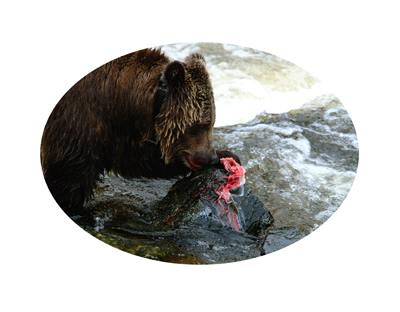Broughton Archipelago II
With an interest in highlighting the broader ecological consequences of fish farming and consequently diminished wild salmon stocks, in October 2005 Zeigler traveled up Knight Inlet in region of the Broughton Archipelago – off the mainland coast of British Columbia – specifically to photograph grizzly bears who rely on native pink salmon stocks as a primary source of food. The list of species affected by the decline in native fish stocks continues to grow, as their prime food source in this region is being severely threatened.
Referencing late 19th century as well as contemporary popular-culture, the oval format used in the depiction of some of these species serves to critique how we obscure our understanding of the “other,” human or non-human, through cultural framing. Other close-ups of sea-lice infected salmon smolts, at once repulsive as well as enticing and oddly beautiful, highlight the cultural objectification of such specimen.
 3. Grizzly Bear 1, Glendale Cove, Knight Inlet, BC, 73 x 106.7 (28.75 x 42”), digital archival pigment print , 2005-07.
3. Grizzly Bear 1, Glendale Cove, Knight Inlet, BC, 73 x 106.7 (28.75 x 42”), digital archival pigment print , 2005-07.
 7. Pink Salmon Smolt , Broughton Archipelago , BC, (110.2 x 111.8 cm (43.4 x 44”), digital archival pigment print .
7. Pink Salmon Smolt , Broughton Archipelago , BC, (110.2 x 111.8 cm (43.4 x 44”), digital archival pigment print .